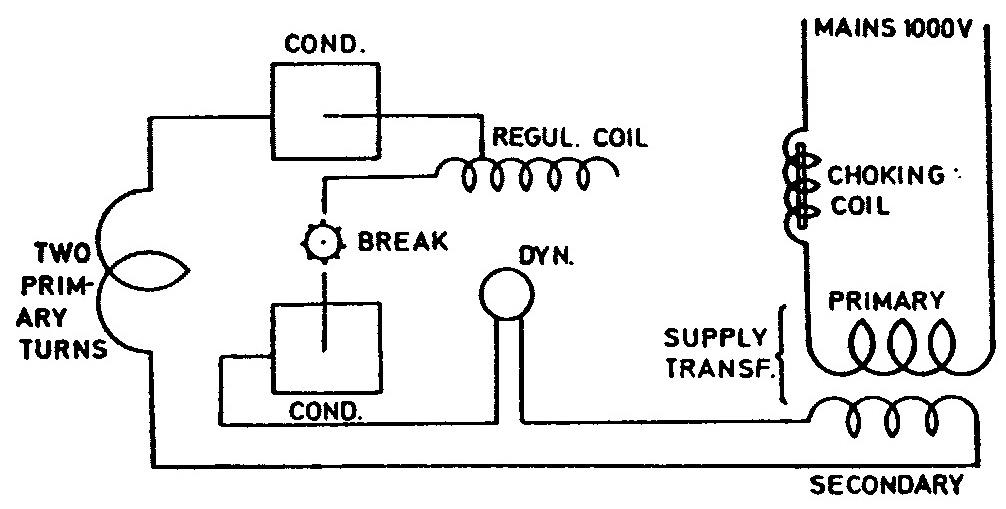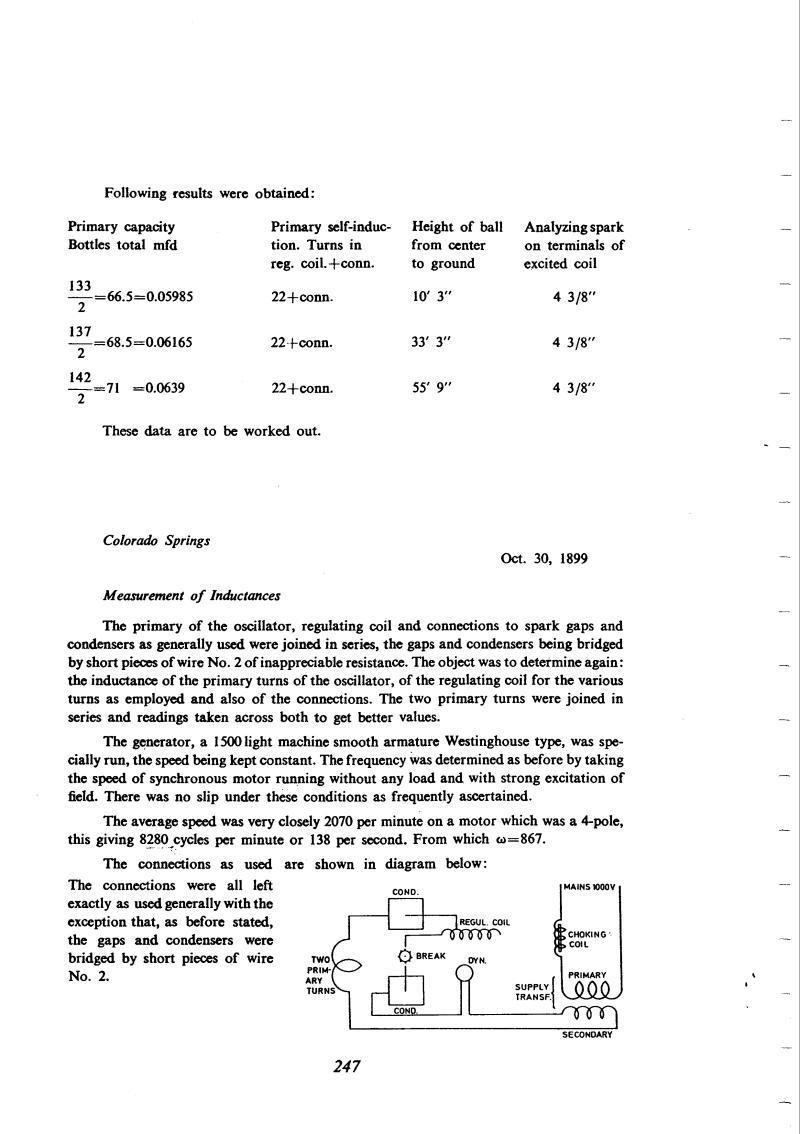
Nikola Tesla Books
Following results were obtained:
| Primary capacity | Primary self-induction. Turns in reg. coil+conn. | Height of ball from center to ground | Analyzing spark on terminals of excited coil | |
|---|---|---|---|---|
| Bottles total | mfd | |||
| $! {{133 \over 2} = 66.5} $! | = 0.05985 | 22 + conn. | 10' 3" | 4 3/8" |
| $! {{137 \over 2} = 68.5} $! | = 0.06165 | 22 + conn. | 33' 3" | 4 3/8" |
| $! {{142 \over 2} = 71} $! | = 0.0639 | 22 + conn. | 55' 9" | 4 3/8" |
These data are to be worked out.
Colorado Springs
Oct. 30, 1899
Measurement of Inductances
The primary of the oscillator, regulating coil and connections to spark gaps and condensers as generally used were joined in series, the gaps and condensers being bridged by short pieces of wire No. 2 of inappreciable resistance. The object was to determine again: the inductance of the primary turns of the oscillator, of the regulating coil for the various turns as employed and also of the connections. The two primary turns were joined in series and readings taken across both to get better values.
The generator, a 1500 light machine smooth armature Westinghouse type, was specially run, the speed being kept constant. The frequency was determined as before by taking the speed of synchronous motor running without any load and with strong excitation of field. There was no slip under these conditions as frequently ascertained.
The average speed was very closely 2070 per minute on a motor which was a 4-pole, this giving 8280 cycles per minute or 138 per second. From which Ï=867.
The connections as used are shown in diagram below:
The connections were all left exactly as used generally with the exception that, as before stated, the gaps and condensers were bridged by short pieces of wire No. 2.
247
October 29
His remark about eddy currents in the sphere is interesting. To prevent their formation he slit the tinfoil with a knife. Did he assume that in the vicinity of the coil the sphere would behave like a short-circuited turn? It is readily shown that if this effect is pronounced (and not taken into account) the measured capacity of the sphere will be too low. This might be an explanation for the reduction of the effective capacity of the sphere in the lowest position (see the calculation of October 28th for an 18" sphere in the lowest position).
October 29
It contains a new measurement series with larger sphere and somewhat changed excitation of the measurement circuit. The excitation is now regulated by an adjustable arcing gap between the lower coil L terminal and grounding (for other details of the scheme please see Oct. 23). The note related to eddy-currents on the globe is very interesting. In order to prevent the occurrence of these currents Tesla makes slits in the metal foil by knife. Did Tesla assume that the sphere in the vicinity of the coil acts like a short circuited turn or something similar? If this effect is distinct and neglected, it is easy to show that the measure value for the sphere will be smaller than actual. It is possible that this effect causes the effective globe capacitance reduction in the lowest position (please see the calculated value obtained on Oct. 28 for the sphere of 18" diameter in the lowest position.)
In some cases Tesla finds that the resonance adjustment is not sharp. By calculation he checks the coil validity factor. The actual validity factor is certainly smaller because Tesla takes the coil resistance at direct current.
October 30-31
He continues measurements, which involve the primary coil of the big high frequency transformer, regulating coil and the inductance of the connections. The wiring scheme is shown on Oct. 30; except that the short circuit is established via a rotating arcing device and a capacitor. So only the above mentioned inductances remain in the circuit. The measurement method has been explained several times so far. As a new item it is explained how the signal of the frequency of approximately 140 Hz is produced and how the frequency measurement is performed.
On Oct. 31 he determines the new coil parameters by measurement. This coil was made by rewinding the coil with 689 turns which was mentioned on Oct. 22. He takes thicker wire in order to improve the quality factor. Measured values he compared with calculated values.


